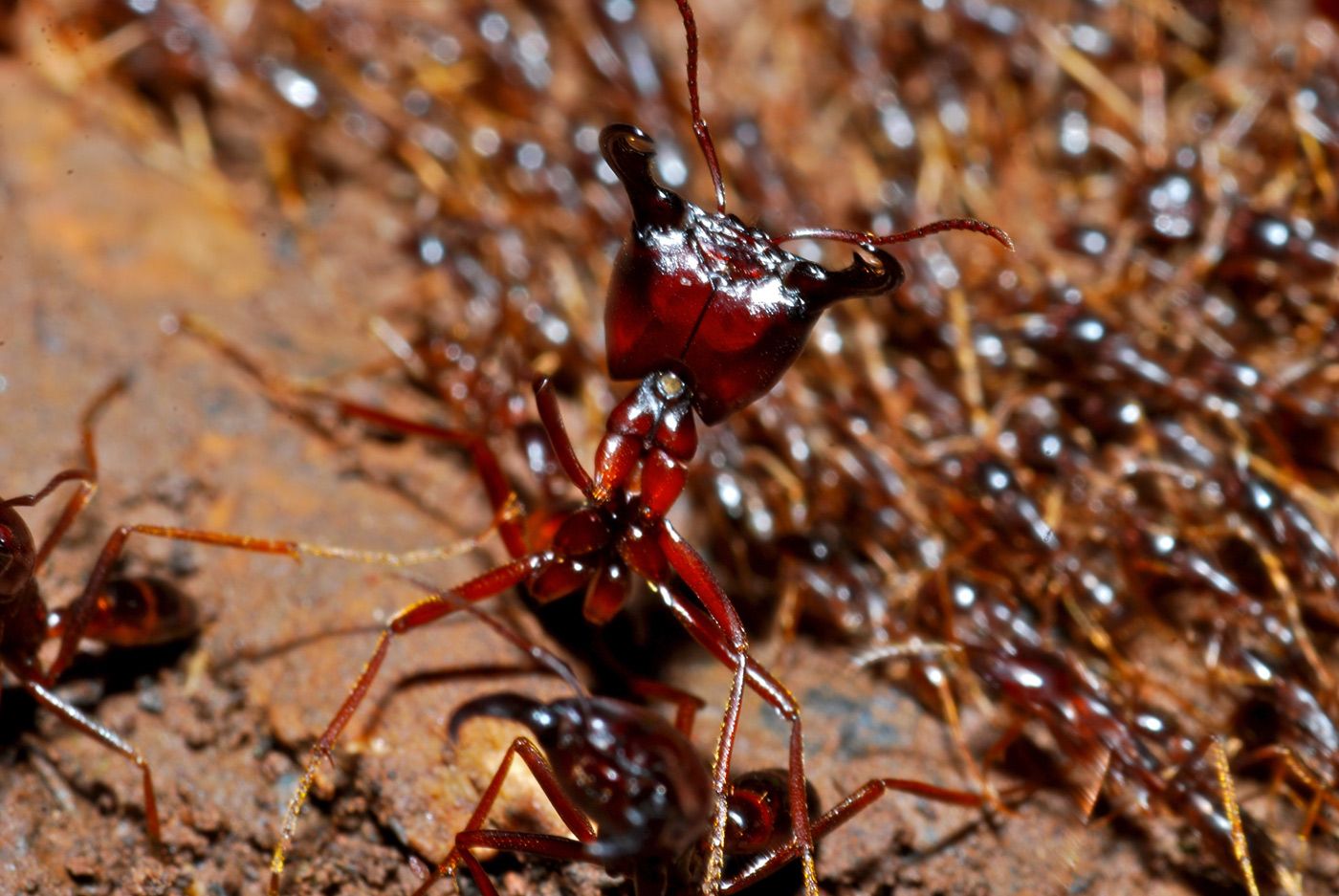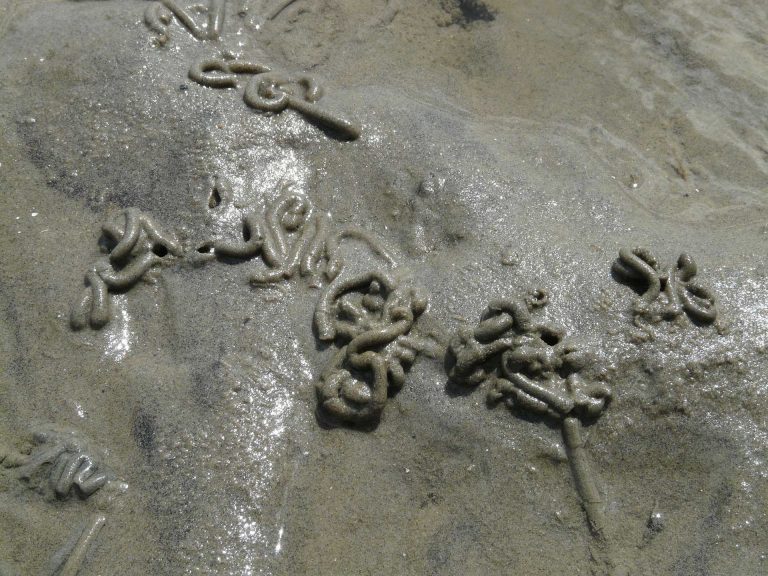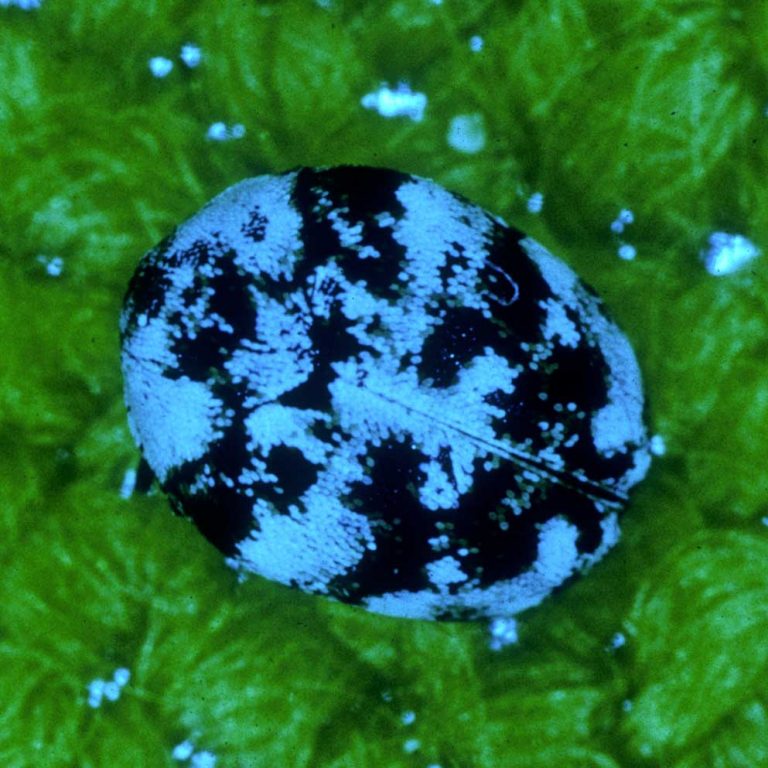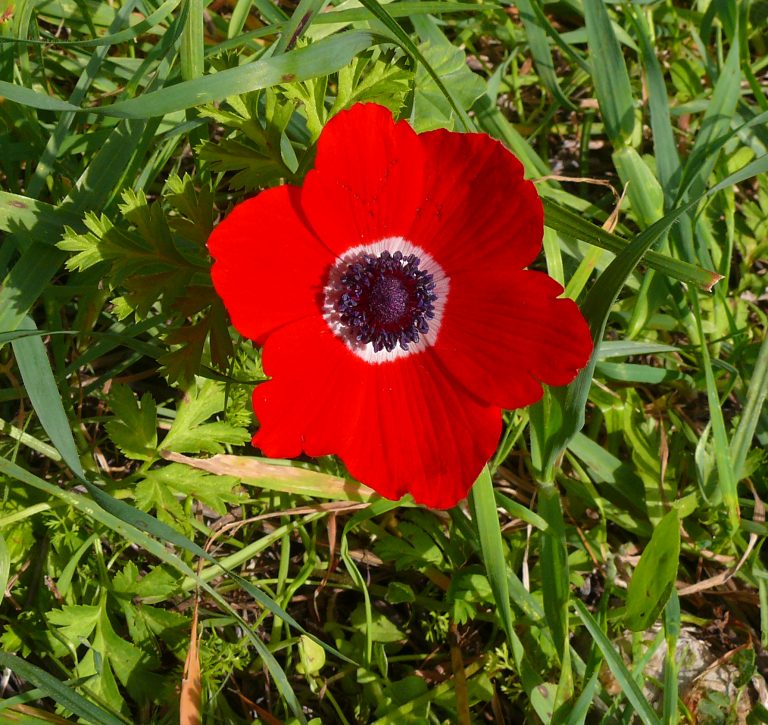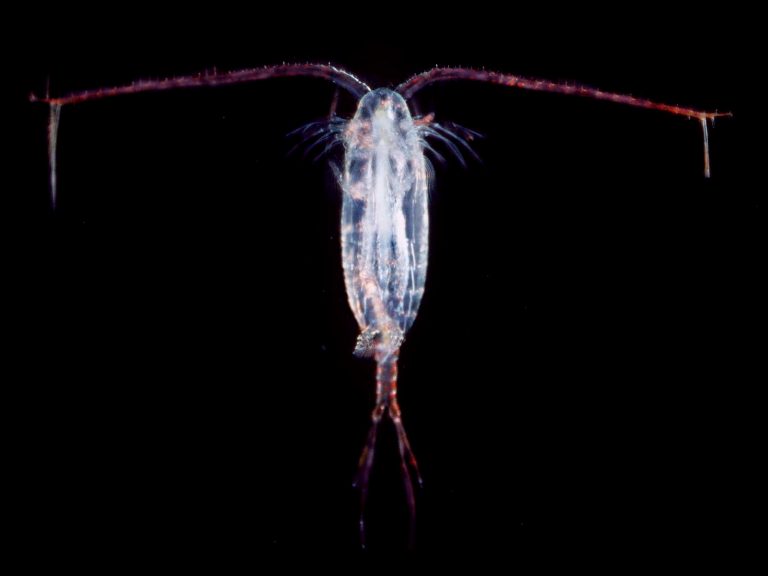Army Ants
Scientific Classification
| Kingdom: | Animalia |
| Phylum: | Arthropoda |
| Class: | Insecta |
| Order: | Hymenoptera |
| Family: | Formicidae |
| Subfamily: | Dorylinae Leach |
| Tribe: | Dorylini Leach |
| Genus: | Dorylus Fabricius |
| Type species: | Vespa Helvola |
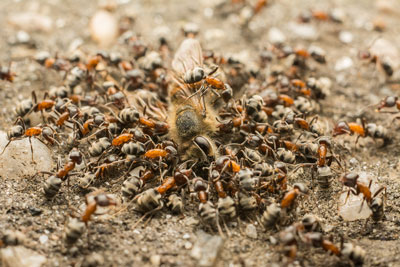
Army ants are also named Marabunta ants or legionary ants; this name is applicable to 200 varieties of ants, with diverse ancestry. On account of their violent and voracious hunting nature, the group is called by the name “raids”, where enormous numbers of ants hunt at a time in a particular location.
An alternative communal attribute is that, quite different from the majority of the ants, the army ants never make their own lasting nests; the colony of the army ant progresses nearly relentlessly till at last it survives. All the varieties are associated with the perfect family of ants, Formicidae. However, many assemblies of ants developed the very same fundamental activities and the environmental syndrome. We frequently refer to this syndrome as “legionary behavior, ” an illustration of convergent growth.
The majority of the army ants of the recent world is from the subordinate family of Ecitoninae, this includes two tribes: Ecitonini and Cheliomyrmecini. There are four genes in the former tribes, namely Nomamyrmex, Eciton, Labidus and Neivamyrmex, whereas there is only one genus in the latter tribe, namely, Cheliomyrmex.
Formerly, the old world and new world ancestry of the army ants were believed to develop separately. This is an illustration of the convergent development. In the year 2003, even though analysis on the heredity of their different varieties recommends that all of them evolved from one ancestor that lived almost 100 million years ago, when there was a division of the two continents South America and Africa Worlds Deadliest: Army Ants Eat Everything
The fidgety and hungry colonies of the army ants are biosphere’s Mongol groups. These ants kill and feed on all that they get on their journey. They tear the food into pieces before digesting them.
The Three Types Of Army Ants
Workers
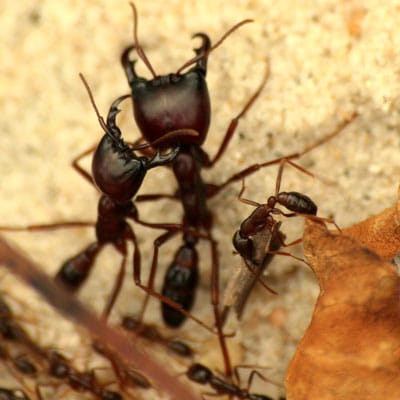
The eyes of the worker army ants are compound and integrated to one lens or normally they are blind. Some of the army ant species have the worker ants exhibiting polymorphism depending on their body dissimilarities also the type of work given to them. But some of them do not exhibit any form of polymorphism. The worker ants are normally sterile females.
Queen
There is only one queen in the true Army ant colony, whereas there are many queens in the other varieties of ant colonies. The queen has a big bulbous posterior, and is basically blind, a characteristic called dichthadiigyne. At times their eyes are vestigial. The uniqueness of the queen army ants are, that they do not have wings, their abdomen is large and cylindrical in shape and they possess large sized Gasters (the posterior bulbous portion belonging to the metasoma in Apocrita Hymenoptera represented by the ants, bees and wasps).. When compared to the worker ants, the queens are bigger in size having an antenna with 10 to 12 segments. On account of their large Gaster the queen mates with numerous males, thus enabling them to lay 3 – 4 million eggs in a month. As a result, the brooding cycles are synchronized and millions of single ants from the same queen, build colonies.
Males
The big male ants have abdomen, which are big and in the shape of a cylinder. Their mandibles are modified and their genitalia is different from those seen in the other species of ants. Their antennae are segmented into 13 numbers, they are elated (possess wings), hence they are similar to wasps. Sexual brooding gives birth to males, which take flight immediately after birth searching for queens for mating. In certain cases where the male ants try mating a queen belonging to the same colony, the worker ants who receive them out of compulsion, forcibly remove their wings so as to allow the big male ants to enter their colony to mate with the queen. On account of their huge figure, at times, such male ants are called by the name “sausage ants or sausage flies”.
Behavior
The reproductive traits and Behavior of these army ants, which includes nomadism, coerced collective foraging, and the special queens that push her workers into becoming a vicious group of social hunters all justify the condition called, “Army Ant Syndrome”
The majority of ant species depute dedicated scouts to search for food . They post other ants in their colony as helpers. However, these army ants send a group of ants without a leader with full authority to locate, overcome the prey immediately and forage.. The army ants do not possess a permanent colony in place, but they form several bivouacs (improvised shelters) during their journey. They regularly travel because they are in search of a great amount of food to feed the large population in their colony. The queens do not have wings and their abdomen enlarges noticeably while producing eggs.
Nomadic and Stationary Phase
The activities of the army ants are comprised of two phases.
The Nomadic (Wandering) Phase
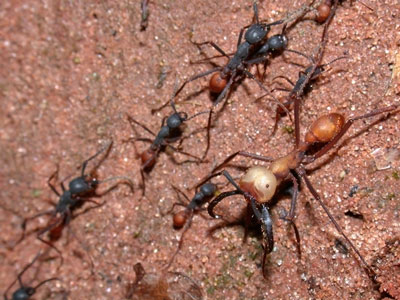
Army Ants – Photo by: Alex Wild
Following 10 days of the queen laying eggs begins the nomadic phase. This lasts for almost 15 days permitting the formation of the larvae. At day these ants wander about conquering spiders, insects and tiny vertebrates to feed their brood. During dusk they make their nests or bivouac that they change every day. When the larvae start spinning pupae, it marks the end of the Nomadic Phase.
Stationary (Statary) Phase
This phase extends to approximately 2 – 3 weeks and starts at the time of the pupation of the larvae. Thereafter, the queens receive all the food that was given to the larvae earlier. The queen’s abdomen (Gaster) bloats noticeably, following which they lay their eggs. When the stationary phase draws to a close, simultaneously the pupae comes out of the cocoons (eclosion) and further generation of eggs are hatched, whereby a fresh group of larvae and workers are in the colony. Now they once again repeat the nomadic phase.
Colony Split
- The Army ants are separated into groups when the colony size attains the threshold size. This takes place almost once in three years.
- The queens, without wings hatch in the midst of broods of male sexes that hatch after some time. When the colony splits, decisions are taken in two ways regarding the new queens.
- One alternative is for the new queen to remain in the creative nest with a part of the male brood and the worker ants and the old queen will go away along with the remaining worker ants in search of a new nest.
- Another alternative is that the worker ants will send away the old queen and the two new colonies will be led by the new queen.
The Queen’s Behavior
Army ants are the biggest ants in the world; therefore army ants like the African Dorylus queen embraces the world record of potential reproduction of all the insects, by having a capacity to lay many millions of eggs in a month. The Army ant queens always stay under the protection of the colony and mate with the foreign male ants that come in. The Truth about the real mating habits of the queen army ants is still a mystery, However, researchers suggest that queen mates with many males. On account of the massive reproduction capacity, a single colony of army ants can develop from just one queen.
On the demise of the queen, there is no substitute and it will not be possible for the army ants to bring up urgent situation queens. Generally on the demise of a queen, the colony too will probably die away. The reasons for the loss of the queen are, attack from predators, accidents in transit, sickness or old age. The only way of preventing the annihilation of a colony is when the queen in the colony dies, is for the worker ants to quickly join with a different colony that possess a queen.
Nesting
Unlike the majority of the ants, Army ants never build their permanent nest, On the contrary, they use their bodies to make a living nest, this is known as a bivouac. We often find these bivouacs in the trunks of trees or in ant made burrows. The bivouac members get hold of each other ant’s legs and join together like a ball, which appears to a layman as an unstructured one, but in fact the structure is well organized, with the elder female worker ants situated outside and the little female workers situated within. The least disturbance, energizes the Army Ant soldiers to assemble above the bivouac, prepared to safeguard the nest with their strong pincers. The Ecitoninae and the Aenictinae type of army ants have the added advantage of their stingers. Inside the nest there are many passages with several chambers that host the food, eggs, larvae and the queen.
Some Interesting Facts About Army Ants at a Glance
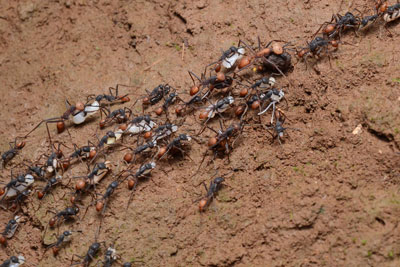
Army Ants – Photo by: Geoff Gallice
- Army Ants are characteristic of not having permanent colonies, but they form a bivouac, where they form a ball of interlinked bodies within tree hollows or rodent burrows.
- Army ants have an antagonistic approach towards not only each other, but also marauding rival colony soldiers during the border disputes that keep colonies apart
- The ant queen represents the boss of the colony of Army Ants, and produces all the eggs that produce the workers that sustain the colony.
- The Army Ant queen mates just once in her life
- Large mandibles are characteristic of Army Ant Soldiers. They use these mandibles to carry heavy loads, kill larger adversaries, and for digging
- An attack by Army Ant soldiers/ workers, is an outrage on the prey, tearing them into pieces during the horrendous horde attack
- Army ant workers never reproduce
- Army ants are normally colored brown, though you can find also black ones.
- The diet of the Army ants includes a variety of insects, small snakes, baby birds and small animals that they attack and tear into pieces, before devouring them.
- Army Ants normally live for about 90 to 390 days
- Army ant colonies are particularly endemic to Central and South America.
- In an hour, Army ants can traverse about 65 feet.
- The biologists claim that the amazing digestive system of the army ants is capable of dissolving and digesting any live animal, humans included.

Having discovered a fondness for insects while pursuing her degree in Biology, Randi Jones was quite bugged to know that people usually dismissed these little creatures as “creepy-crawlies”.

